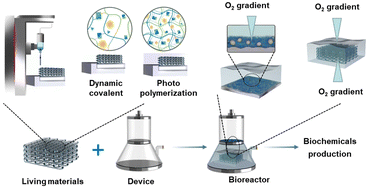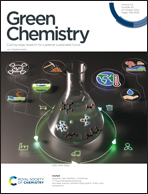Spatial niche construction of a consortium-based consolidated bioprocessing system†
Abstract
A synthetic microbial consortium for consolidated bioprocessing (CBP) is considered a promising approach for the biochemical production owing to the efficient division of labor and anticipated favorable economic performance. The current development of synthetic biology has enabled to convert complex substrates to targeted metabolites; however, it remains challenging to construct a CBP system to meet the requirements of differing abiotic conditions such as oxygen concentration. Herein, a 3D bioprinting of living materials containing product-forming anaerobes from a novel type of dual-stage crosslinked yeast-loaded hydrogel bioink (PVA-GMA/PBA-SA) with the advantages of long-term metabolic activities in 9 continuous batch processes and recycling properties are presented. Compared with the suspension fermentation, the maximum yield and productivity of ethanol were increased by 1.9 and 7.2 times, respectively. Moreover, a bioreactor with custom-designed living materials and a 3D printed device for the CBP system was developed, providing defined spatial niches fitting specific oxygen needs. Moreover, the designed enforced spatial niches were successfully applied in a consortium-based CBP system, which was able to produce 12.5 g L−1 ethanol and 13.8 g L−1 lactate from the microcrystalline cellulose.



 Please wait while we load your content...
Please wait while we load your content...